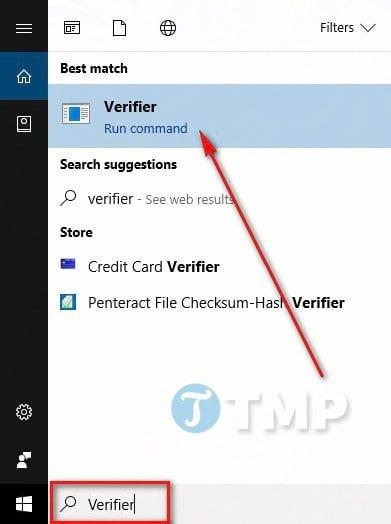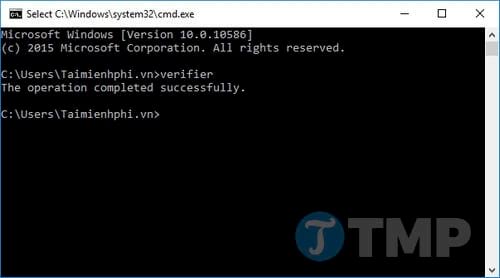Instructions to enable/disable Driver Verifier to avoid system errors
Need to check for faulty drivers on Windows 10 but are worried about running into problems? This guide helps you safely enable/disable Driver Verifier to avoid unwanted system errors.
How to run Driver Verifier
The most common way is to type Verifier into the Search box on the Taskbar, then click Verifier Run command .

Alternatively you can also open CMD, and type Verifier in there and press Enter.

Finally, you can open the Win 10 Task Manager , then create a new task and select to open Verifier. To do this, click File , then select Run new task .

On the Create new task window, in the Open box, enter Verifier and click OK.

The Verifier will now run.
Configure Driver Verifier settings
Once Verifier is open, the next step is to configure and enable the settings for Verifier to work properly. First, select the Create custom settings (for code developers) option , then click the Next button at the bottom.

Check Select driver names from a list , then select the Next button again.

Next, check the options I/O verification , Force pending I/O requests and IRP Logging and click Next .

All you need to do now is check the list and check all the non-Microsoft drivers. To see if the drivers are from Microsoft or not, look in the Provider column.

Click the Finish button at the bottom of the list.

How to disable (turn off) Driver Verifier?
If you want to disable it completely, just run Verifier again like in the steps above (via the Search box, Command Prompt or Task Manager), then select Delete existing settings from the menu. Then click the Finish button to turn off (disable) Driver Verfier.

Driver Verifier helps check for faulty drivers on Windows, but can cause blue screen errors (BSOD) if not used properly. If you encounter problems, you can disable Driver Verifier using Command Prompt or enter Safe Mode to fix driver errors.
You should read it
- The best driver update software for computers
- Driver Talent - Free Driver Updater
- Update driver, the software automatically finds driver for the computer, Laptop
- Summary of free driver backup software
- Driver Driver installation software for computers
- Donate key Driver Booster 6 Pro 6 months, activate before October 31, 2018
- How to use Driver Talent for free driver updates
- How to check the current Driver version of the computer
May be interested
- Instructions to block automatic driver installation on Windows 11
 although windows 11 can download drivers for your computer without user intervention, you don't always want to install drivers automatically to avoid unwanted problems.
although windows 11 can download drivers for your computer without user intervention, you don't always want to install drivers automatically to avoid unwanted problems. - Instructions to thoroughly remove the VGA card driver on Windows 10
 how to remove vga driver on windows 10 operating system thoroughly and safely? how to use display driver uninstaller (ddu) to remove vga driver
how to remove vga driver on windows 10 operating system thoroughly and safely? how to use display driver uninstaller (ddu) to remove vga driver - The best driver update software for computers
 update drivers that can be done manually or use driver update software. the advantage of using driver update software is fast, convenient and find the right driver to update. here are some software updates and install the best driver for your reference.
update drivers that can be done manually or use driver update software. the advantage of using driver update software is fast, convenient and find the right driver to update. here are some software updates and install the best driver for your reference. - Update the system driver with Windows 7 Device Installation Settings
 during windows installation, we will definitely see the screen shown below, when the system prompts the user for how to install and apply updates:
during windows installation, we will definitely see the screen shown below, when the system prompts the user for how to install and apply updates: - How to check the current Driver version of the computer
 basically, drivers are computer programs that help windows operating systems and other applications interact with hardware devices. if you want to personally check the current version of driver, you can refer to the following instructions.
basically, drivers are computer programs that help windows operating systems and other applications interact with hardware devices. if you want to personally check the current version of driver, you can refer to the following instructions. - Top 5 software to Backup (Restore) and Restore (Restore) the best Computer Driver
 in the process of using the computer will be very difficult to avoid errors, so backing up the driver is necessary in case of a risk. the following article of tipsmake.com will introduce to you the 5 best software backup and restore software for your computer today, please refer.
in the process of using the computer will be very difficult to avoid errors, so backing up the driver is necessary in case of a risk. the following article of tipsmake.com will introduce to you the 5 best software backup and restore software for your computer today, please refer. - 11 tips to fix any common errors on Mac
 macos is a reliable operating system but it also cannot avoid fundamental errors and needs to be fixed. the following article summarizes the 11 fastest ways to fix common errors such as slow system, application crashes or non-responding, ...
macos is a reliable operating system but it also cannot avoid fundamental errors and needs to be fixed. the following article summarizes the 11 fastest ways to fix common errors such as slow system, application crashes or non-responding, ... - Driver Talent - Free Driver Updater
 originally released as drivethelife, driver talent is a driver manager developed by ostoto software. driver talent helps users keep their hardware drivers up to date.
originally released as drivethelife, driver talent is a driver manager developed by ostoto software. driver talent helps users keep their hardware drivers up to date. - How to fix computer errors without completely turning off the power
 computer shutdown is very simple and everyone can do it. however, many computers do not have full power off, the power light is on.
computer shutdown is very simple and everyone can do it. however, many computers do not have full power off, the power light is on. - 4 Ways to update Win 11 Driver, quick update tips
 windows has an automatic driver update tool, but in some situations you need to update manually to fix errors. here is how to update win 11 driver manually, ensuring that your computer operates stably and safely.
windows has an automatic driver update tool, but in some situations you need to update manually to fix errors. here is how to update win 11 driver manually, ensuring that your computer operates stably and safely.










 7 fastest ways to open Task Manager on Windows
7 fastest ways to open Task Manager on Windows How to reset One Note on Windows 10, delete One Note data on Windows 10
How to reset One Note on Windows 10, delete One Note data on Windows 10 How to put Control Panel in the right-click menu on Windows 10
How to put Control Panel in the right-click menu on Windows 10 How to quickly turn off Windows 10 PIN, avoid login errors
How to quickly turn off Windows 10 PIN, avoid login errors How to set password to protect files on Windows 10
How to set password to protect files on Windows 10 Open Files and Folders Quickly on Windows 10 with Just 1 Click
Open Files and Folders Quickly on Windows 10 with Just 1 Click